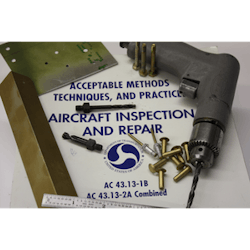In the world of aircraft construction and repair, aircraft fasteners are utilized to assemble detail parts that are combined together with other parts into assemblies, which are assembled into installations that finally end up as a complete aircraft.
An interesting statistic is aircraft fasteners make up half of the 6,000,000 parts used to fabricate a Boeing 747-800 aircraft.
The purpose of the fastener is to connect all the different parts together in primary structural areas, secondary structure, pressurized and nonpressurized applications, and to transfer loads from one part to another in both production and repair applications.
Fastener information may be found in various sources which may include the specific aircraft maintenance manual chapter 20, the specific aircraft structural repair manual, or aircraft production and repair drawings. Advisory Circular 43.13-1B and the Aircraft General Handbook which can be found online at the FAA web site http://www.faa.gov also contain fastener information.
Fastener utilization and types
When engineers design an aircraft many things are considered when choosing the correct type of fastener. The type of joint the fastener will be exposed to in its application; shear or tension. What types of loads will be transferred through the joint. Aircraft loads may include those experienced during towing, normal flight operations, wind-gusts, pressurization, engine-out operations, landing, and more. All of this will determine how thick or thin the structure will have to be, the material type of the original structure, and the associated fasteners.
Fasteners must be able to achieve the transfer of load from one part to another. An example of this is the load transferred from an engine to a pylon, the pylon load to the wing, and the wing to fuselage. Fastener numbers and diameter are calculated to transfer this load. Other criteria are also needed to select the best fastener for the installation. This could include weight, inspect ability, tooling requirements, aerodynamic smoothness, access, corrosion protection, and of course cost.
Fasteners can be placed into many groupings which may be used as structural fasteners that take aircraft loads, to nonstructural fasteners that connect nonload bearing parts. There are restricted access applications or blind fasteners such a Huck Lock Bolts, Composi-Locks Fasteners, and CherryMAX fasteners.
For areas with access to both sides, standard rivets, structural bolts, and Hi-Lok fastening system fasteners are used. Materials for these fasteners include aluminum, steel, and titanium and are coated to prevent dissimilar metal corrosion. Styles of fastener heads vary from countersunk to protruding head based on the aerodynamic requirements of the aircraft.
Fastener codes and orientation
Fastener coding can be designated by the fastener manufacturer such as a CR3233 CherryMAX rivet, by an industry standard such an AN4 bolt, or by the airframe manufacturer as in a BACR15CE5D3 rivet from Boeing. Coding descriptions can be found in various fastener books, on the repair drawing, or on the production blueprint. Also fastener codes may be used to simplify repair and productions drawings. These fastener codes may be found in the upper-left part of the drawing quadrant.
It is standard for the head of a fastener to be installed head-up, or head-forward. However, the blueprints and repair drawing will give proper orientation in the fastener quadrant, normally the upper-right corner of the fastener quadrant, and will call-out the fastener head near or far based on the view of the drawing.
Some aircraft doublers applications can be creative, such as requiring a thin titanium doubler installed on the inside of the aircraft skin. In this specific example, the head of the rivet is on the inside of the fuselage and the outside skin is countersunk 82 degrees with the rivets bucked into the countersunk then shaved to flush for smoothness.
Joint design
In the design of a fastener joint the fastener must remain intact and not fail based on the ultimate load design of the joint. If the fasteners were to fail, the joint would simply come apart. In an ultimate joint failure the idea is for the joint to tear apart. If an improper joint is designed, the result could be a material shear-out failure, material tension failure, or fastener shear failure which is generally caused by the wrong diameter or material fastener, or insufficient fastener edge-margin.
Requirements for edge-margin, the distance from the center of the fastener to the edge of the part, and the distance from the center of a fastener to the center of the next fastener must be observed to ensure a proper joint. During aircraft fatigue testing it has been found that an equally spaced fastener joint will outperform a staggered fastener joint design. However, a staggered fastener joint design is favored in fuel tank applications as they provide a greater faying surface sealing area.
Process driven
Adherence to proper process is critical for the installation of aircraft fasteners. Like the aviation saying “Inspection cannot build quality into a part, it merely verifies its presence” applies to aircraft fasteners. Once a solid rivet is bucked, the Hi-Lok collar is tightened, or the blind-rivet is pulled, the quality of both the hole and countersink are not visible.
Traditionally when countersinking, it is acceptable to have the fastener a little above flush rather than below flush after installation. The only exception would be near an area having specific aerodynamic smoothness requirements such as near the reduced vertical separation minimums (RVSM) critical part areas. Countersinking below flush can create a knife-edge condition between the layers of materials and can eventually cause a crack emanation or shearing of the fastener head.
Proper fastener-hole size and finish must be maintained based on the fastener type and material the fastener is going through. Rivets are traditionally installed in a clearance-fit whereas the hole is larger than the fastener. Bolts and Hi-Loks are installed in a transition-fit hole where the fastener and structure are roughly the same size. In some cases a fastener being installed into steel or titanium requires a close-ream hole to prevent the removal of protective coating on the fastener during installation. To get an exact and quality size and finish hole the use of reamers and core drills are required. The key is to have all of the fasteners in an area or repair to “load-up” together.
Inspection/removal/substitution
Criteria for inspection, removal, and substitution of aircraft fasteners must be closely followed in order to carry the load through an aircraft structure. The criteria may be found in the previously mentioned references. If removal of a fastener is required for additional access or because of improper installation, care must be observed to prevent damage to surround structure and the fastener hole itself. Some fastener substitutions are allowed per the airframe manufacturer if the replacement fastener meets or exceeds the original strength, diameter, and corrosion protection characteristics.
After the aircraft, engine, or component manufacturer, or the repair engineer designs an assembly or repair, adherence to the maintenance and repair process is critical for loading and unloading of the fastener joint throughout its service life.
Marty Holzer is a certified AMT currently working as a line maintenance technician for Delta Airlines. Over the last 25 years he has worked in aircraft manufacturing, MRO, line maintenance, and as a technical instructor. Holzer has developed and taught structural repair courses which including reading and interpreting drawings for structural repair on commercial airline aircraft. He can be reached at email [email protected].

